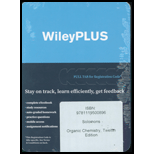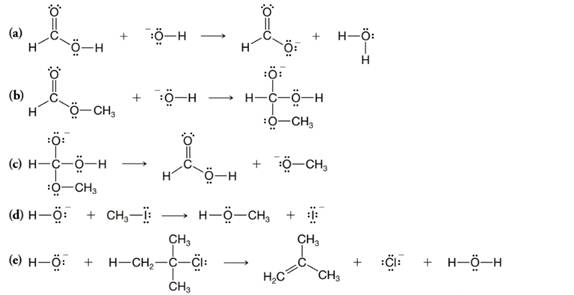
ORGANIC CHEMISTRY-WILEYPLUS ACCESS PKG.
12th Edition
ISBN: 9781119766919
Author: Solomons
Publisher: WILEY
expand_more
expand_more
format_list_bulleted
Concept explainers
Textbook Question
Chapter 3, Problem 38P
Supply the curved arrows necessary for the following reactions:

Expert Solution & Answer
Want to see the full answer?
Check out a sample textbook solution
Students have asked these similar questions
Identify the glycosidic linkage.
Draw the mechanism for the substitution reaction converting an alcohol into an alkyl halide. If chirality is important to the reaction include it.
Write, in words three different reactions we can use to make an alcohol.
Chapter 3 Solutions
ORGANIC CHEMISTRY-WILEYPLUS ACCESS PKG.
Ch. 3 - Prob. 1PPCh. 3 - PRACTICE PROBLEM 3.2
Write equations showing the...Ch. 3 - PRACTICE PROBLEM 3.3 Which of the following are...Ch. 3 - Prob. 4PPCh. 3 - PRACTICE PROBLEM 3.5 Formic acid (HCO2H) has...Ch. 3 - Prob. 6PPCh. 3 - Prob. 7PPCh. 3 - Prob. 8PPCh. 3 - PRACTICE PROBLEM 3.9 Predict the outcome of the...Ch. 3 - Prob. 10PP
Ch. 3 - Prob. 11PPCh. 3 - Prob. 12PPCh. 3 - Prob. 13PPCh. 3 - Prob. 14PPCh. 3 - PRACTICE PROBLEM 3.15 Nitro groups have a large...Ch. 3 - PRACTICE PROBLEM 3.16
Your laboratory instructor...Ch. 3 - Prob. 17PPCh. 3 - Prob. 18PPCh. 3 - Prob. 19PPCh. 3 - What is the conjugate base of each of the...Ch. 3 - List the bases you gave as answers to Problem 3.20...Ch. 3 - 3.22 What is the conjugate acid of each of the...Ch. 3 - List the acids you gave as answers to Problem 3.22...Ch. 3 - Rank the following in order of increasing acidity.Ch. 3 - Without consulting tables, select the stronger...Ch. 3 - Designate the Lewis acid and Lewis base in each of...Ch. 3 - Prob. 27PCh. 3 - Prob. 28PCh. 3 - Write an equation, using the curved-arrow...Ch. 3 - 3.30 What reaction will take place if ethyl...Ch. 3 - 3.31 (a) The of formic acid. What is the? (b)...Ch. 3 - Acid HA has pKa=20; acid HB has pKa=10. (a) Which...Ch. 3 - Prob. 33PCh. 3 - 3.34 (a) Arrange the following compounds in order...Ch. 3 - 3.35 Arrange the following compounds in order of...Ch. 3 - 3.36 Arrange the following in order of increasing...Ch. 3 - Prob. 37PCh. 3 - 3.38 Supply the curved arrows necessary for the...Ch. 3 - Glycine is an amino acid that can be obtained from...Ch. 3 - 3.40 Malonic acid, , is a diprotic acid. The for...Ch. 3 - 3.41 The free-energy change, , for the ionization...Ch. 3 - 3.42 At the enthalpy change, , for the ionization...Ch. 3 - The compound at right has (for obvious reasons)...Ch. 3 - 3.44.
(a) Given the above sequence of...Ch. 3 - Prob. 45PCh. 3 - Prob. 46PCh. 3 - 3.47 As noted in Table 3.1, the of acetone, , is...Ch. 3 - Formamide (HCONH2) has a pKa of approximately 25....Ch. 3 - List all the chemical species likely to be present...Ch. 3 - Prob. 2LGPCh. 3 - Prob. 3LGPCh. 3 - Prob. 4LGP
Additional Science Textbook Solutions
Find more solutions based on key concepts
Why would it be impossible for organisms to grow at 200 or 300C?
Brock Biology of Microorganisms (15th Edition)
As the air moves up the windward side of the mountain, will it get cooler or warmer?
Applications and Investigations in Earth Science (9th Edition)
51. Classify each compound as ionic or molecular. If it is ionic, determine whether the metal forms only one ty...
Introductory Chemistry (6th Edition)
The glycine cleavage system is a group of four enzymes that together catalyze the following reaction: glycine+T...
Organic Chemistry (8th Edition)
1.1 Write a one-sentence definition for each of the following:
a. chemistry
b. chemical
Chemistry: An Introduction to General, Organic, and Biological Chemistry (13th Edition)
Q1. Which wavelength of light has the highest frequency?
a) 10 nm
b) 10 mm
c) 1 nm
d) 1 mm
Chemistry: A Molecular Approach (4th Edition)
Knowledge Booster
Learn more about
Need a deep-dive on the concept behind this application? Look no further. Learn more about this topic, chemistry and related others by exploring similar questions and additional content below.Similar questions
- Name the following carbohydrates give both the systematic and common names. Don't forget to identify the Isomer.arrow_forwardWhat is the product of the reaction of XeF4 with H2O? Group of answer choices H2XeF2 H2XeF4 XeO3 H2XeOarrow_forwardWhile noble gas exerts the strongest London (dispersion) forces on neighboring atoms? Group of answer choices Xe Ar Kr Nearrow_forward
- Which of the following elements is corrosive to your skin due to that element breaking down C=C bonds? Group of answer choices fluorine iodine bromine chlorinearrow_forwardWhat the best source of sulfide to use on a small scale in the lab? Group of answer choices thiourea H2S NaHS Na2Sarrow_forwardWhich of the following statements about sulfur is FALSE? Group of answer choices H2S is the product of an oxygen-depleted ecosystem. In the acid mine drainage reaction, FeS2 is a product. One allotrope of sulfur has the formula S20. In the environment, bacterial oxidation can convert S2− to elemental S or SO42−.arrow_forward
- Of the following choices, which is the best reason that most materials DON'T spontaneously combust even though our atmosphere is about 21% oxygen? Group of answer choices The reduction of O2 in the gas phase (O2 + e− → O2−) is spontaneous. The reduction of O2 in acid solution (O2 + H+ + e− → HO2(aq)) is spontaneous. O2 is not a reactant in combustion. The O2 bond dissociation energy is 494 kJ/mol, leading to a high activation energy for combustion.arrow_forwardplease answer in the scope of the SCH4U course, I am having a hard time understanding, may you show all steps please and thank you! can you also put the final answers in the table so its understandablearrow_forwardPlan the synthesis of the following compound using the starting material provided and any other reagents needed as long as carbon based reagents have 3 carbons or less. Either the retrosynthesis or the forward synthesis (mechanisms are not required but will be graded if provided) will be accepted if all necessary reagents and intermediates are shown (solvents and temperature requirements are not needed unless specifically involved in the reaction, i.e. DMSO in the Swem oxidation or heat in the KMnO4 oxidation). There may be more than one correct answer, and chemically correct steps will be accepted. Extra points will be given if correct names are provided. The points earned here will be applied to your lowest exam score! H Harrow_forward
arrow_back_ios
SEE MORE QUESTIONS
arrow_forward_ios
Recommended textbooks for you
 Chemistry for Today: General, Organic, and Bioche...ChemistryISBN:9781305960060Author:Spencer L. Seager, Michael R. Slabaugh, Maren S. HansenPublisher:Cengage Learning
Chemistry for Today: General, Organic, and Bioche...ChemistryISBN:9781305960060Author:Spencer L. Seager, Michael R. Slabaugh, Maren S. HansenPublisher:Cengage Learning Organic ChemistryChemistryISBN:9781305580350Author:William H. Brown, Brent L. Iverson, Eric Anslyn, Christopher S. FootePublisher:Cengage Learning
Organic ChemistryChemistryISBN:9781305580350Author:William H. Brown, Brent L. Iverson, Eric Anslyn, Christopher S. FootePublisher:Cengage Learning Organic Chemistry: A Guided InquiryChemistryISBN:9780618974122Author:Andrei StraumanisPublisher:Cengage Learning
Organic Chemistry: A Guided InquiryChemistryISBN:9780618974122Author:Andrei StraumanisPublisher:Cengage Learning Chemistry: The Molecular ScienceChemistryISBN:9781285199047Author:John W. Moore, Conrad L. StanitskiPublisher:Cengage Learning
Chemistry: The Molecular ScienceChemistryISBN:9781285199047Author:John W. Moore, Conrad L. StanitskiPublisher:Cengage Learning

Chemistry for Today: General, Organic, and Bioche...
Chemistry
ISBN:9781305960060
Author:Spencer L. Seager, Michael R. Slabaugh, Maren S. Hansen
Publisher:Cengage Learning

Organic Chemistry
Chemistry
ISBN:9781305580350
Author:William H. Brown, Brent L. Iverson, Eric Anslyn, Christopher S. Foote
Publisher:Cengage Learning

Organic Chemistry: A Guided Inquiry
Chemistry
ISBN:9780618974122
Author:Andrei Straumanis
Publisher:Cengage Learning

Chemistry: The Molecular Science
Chemistry
ISBN:9781285199047
Author:John W. Moore, Conrad L. Stanitski
Publisher:Cengage Learning
General Chemistry | Acids & Bases; Author: Ninja Nerd;https://www.youtube.com/watch?v=AOr_5tbgfQ0;License: Standard YouTube License, CC-BY